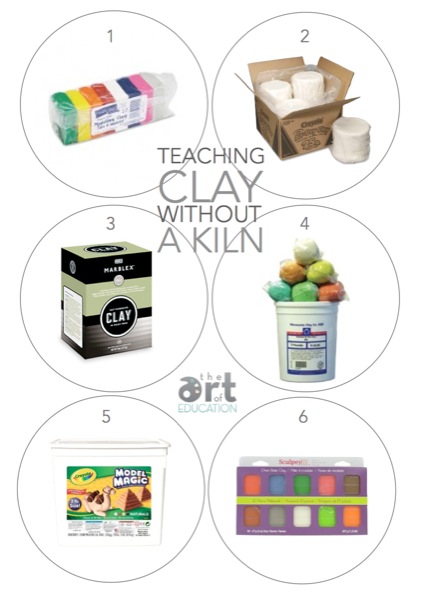What some art teachers would consider a necessity and staple in their art rooms, other art teachers survive day in and day out with out one.
What is it? A Kiln.
The reality is, kilns are expensive, and not all schools have the budget for the expense of purchasing, running and maintaining a kiln. Because working in 3D is one of the hallmarks of a balanced art curriculum, many creative teachers around the country are finding ways to give their students a quality 3D art experience without breaking the budget.
Although I personally have experience using a kiln for most of my ceramic needs in the classroom, sometimes budget, traveling schedules and simple ease, I often find it beneficial to turn to alternative methods of clay to fill in the gaps of my clay curriculum. Today I would like to review some methods I have used in the past, as well as some other products floating around out there. This guide is meant to help all art teachers (and art enthusiasts) make the best decision when working without a kiln, but still have that passion and desire to expose their students to quality clay experiences.
1. Modeling Clay
Modeling clay is a nice clay for practicing before an actual clay project. Because it doesn’t harden completely, great for practicing, but the consistency is not that of real clay, so there is a bit of a disconnect and I find it to be sticky and oily.
2. Crayola Air Dry Clay
Not too shabby of a project. Acts and attaches like earthenware clay. Paint adheres “ok” – The colors aren’t as bold, but I had good luck with water color paints or tempera cakes on them and then doing a spray finish to make it glossy and seal it. Metallic paints work great on air dry clay, and really cover up any imperfections. The price is reasonable.
3. Marblex Air Dry Clay
This product is found in the Amaco catalog, and works much like earthenware. You can paint it once the product is fully dry, and the grey color is realistic to actual earthenware clay. At $10 for 5 lbs, my earthenware is about 3/4ths the cost, however, if you choose smaller projects, this might stretch your budget nicely.
4. Rainbow Air Dry Clay
This product is from Minnesota Clay. It’s an air dry clay that acts like earthen ware, and comes in a variety of colors. Someone has even thrown on the wheel with it! I saw some finished pieces of this clay at a conference, and I was impressed. Tomorrow I am going to be conducting a more detailed review of this product and a giveaway of this clay, so please come back for more ‘air dry clay’ fun.
5. Crayola Model Magic
Yes, I’ve used this for pinch pots in Kindergarten and it works fairly well. You can draw on this with thin markers, which was kind of fun, after it dried. However, when given the choice, I would pick the Crayola Air Dry or Rainbow Clay over this product any day. Mainly because you can slip and score with the other, and treat it more like real clay. Model Magic does have its place, but I would use sparingly. It can be difficult for students to manipulate, and ‘bounces back’ when they try to mold it. Plus, it’s expensive and drys out very quickly if you purchase a large tub.
6. Sculpey
Some teachers swear by this product. This polymer clay product is probably best for middle school or secondary students who want to make smaller sculptures, and because it’s expensive, all you can afford is a smaller scale project, anyway. The things people can create with sculpey continue to blow my mind. This product has it’s place in art rooms, if you can afford it.
Other Ideas to Stretch Your Clay (and Budget) Further
Keep Projects Small
You could have students create jewelry, Amulets from Egypt, smaller medallions, medals, etc. Students could make small pinch pot critters, small boxes for kids to hold paper clips or jewelry or little lego pieces. As far as color goes, I really stuck with plain white, but like I said, it’s a huge process to paint, and then glaze or spray a clear gloss over the air dry, so maybe color would be kind of fun and eliminate a step or two. Then you could just paint on a clear acrylic seal and it would be shiny an polished.
Divide and Conquer
You could also consider doing ceramics with only half of the school and perhaps doing paper mache, paper sculpture, wire mobiles, etc (other forms of 3D art) and trade off grade levels each year. My favorite wire to use for sculptures (a la Calder) is Twisteez Wire.
Please share how you handle “Teaching Clay Without a Kiln”
What other products do you use and love? What products aren’t worth the money?
Magazine articles and podcasts are opinions of professional education contributors and do not necessarily represent the position of the Art of Education University (AOEU) or its academic offerings. Contributors use terms in the way they are most often talked about in the scope of their educational experiences.





